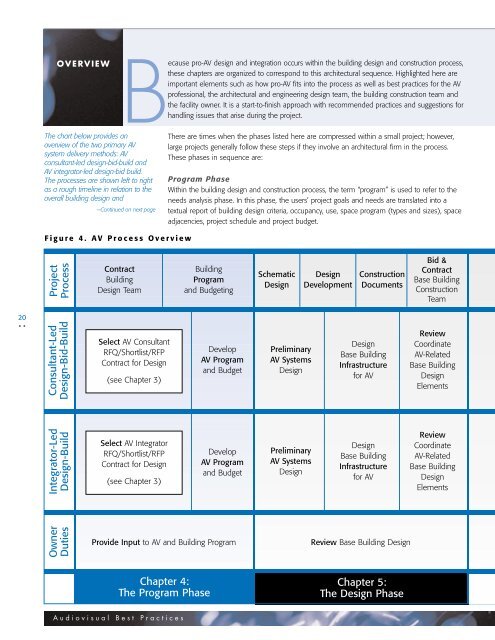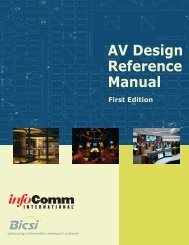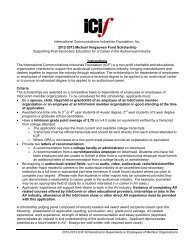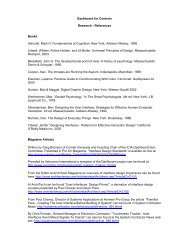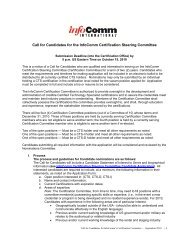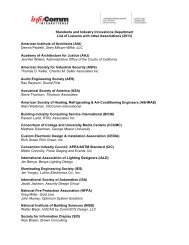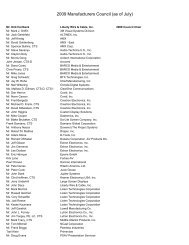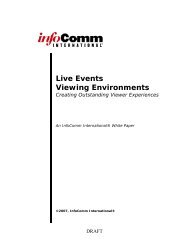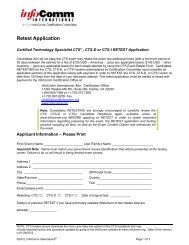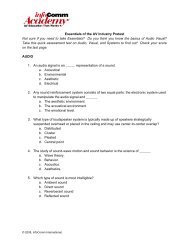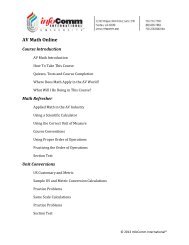AV Process Overview - InfoComm
AV Process Overview - InfoComm
AV Process Overview - InfoComm
Create successful ePaper yourself
Turn your PDF publications into a flip-book with our unique Google optimized e-Paper software.
OVERVIEW<br />
B<br />
ecause pro-<strong>AV</strong> design and integration occurs within the building design and construction process,<br />
these chapters are organized to correspond to this architectural sequence. Highlighted here are<br />
important elements such as how pro-<strong>AV</strong> fits into the process as well as best practices for the <strong>AV</strong><br />
professional, the architectural and engineering design team, the building construction team and<br />
the facility owner. It is a start-to-finish approach with recommended practices and suggestions for<br />
handling issues that arise during the project.<br />
The chart below provides an<br />
overview of the two primary <strong>AV</strong><br />
system delivery methods: <strong>AV</strong><br />
consultant-led design-bid-build and<br />
<strong>AV</strong> integrator-led design-bid build.<br />
The processes are shown left to right<br />
as a rough timeline in relation to the<br />
overall building design and<br />
—Continued on next page<br />
There are times when the phases listed here are compressed within a small project; however,<br />
large projects generally follow these steps if they involve an architectural firm in the process.<br />
These phases in sequence are:<br />
Program Phase<br />
Within the building design and construction process, the term “program” is used to refer to the<br />
needs analysis phase. In this phase, the users’ project goals and needs are translated into a<br />
textual report of building design criteria, occupancy, use, space program (types and sizes), space<br />
adjacencies, project schedule and project budget.<br />
Figure 4. <strong>AV</strong> <strong>Process</strong> <strong>Overview</strong><br />
Project<br />
<strong>Process</strong><br />
Contract<br />
Building<br />
Design Team<br />
Building<br />
Program<br />
and Budgeting<br />
Schematic<br />
Design<br />
Design<br />
Development<br />
Construction<br />
Documents<br />
Bid &<br />
Contract<br />
Base Building<br />
Construction<br />
Team<br />
20<br />
• •<br />
Consultant-Led<br />
Design-Bid-Build<br />
Select <strong>AV</strong> Consultant<br />
RFQ/Shortlist/RFP<br />
Contract for Design<br />
(see Chapter 3)<br />
Develop<br />
<strong>AV</strong> Program<br />
and Budget<br />
Preliminary<br />
<strong>AV</strong> Systems<br />
Design<br />
Design<br />
Base Building<br />
Infrastructure<br />
for <strong>AV</strong><br />
Review<br />
Coordinate<br />
<strong>AV</strong>-Related<br />
Base Building<br />
Design<br />
Elements<br />
Integrator-Led<br />
Design-Build<br />
Select <strong>AV</strong> Integrator<br />
RFQ/Shortlist/RFP<br />
Contract for Design<br />
(see Chapter 3)<br />
Develop<br />
<strong>AV</strong> Program<br />
and Budget<br />
Preliminary<br />
<strong>AV</strong> Systems<br />
Design<br />
Design<br />
Base Building<br />
Infrastructure<br />
for <strong>AV</strong><br />
Review<br />
Coordinate<br />
<strong>AV</strong>-Related<br />
Base Building<br />
Design<br />
Elements<br />
Owner<br />
Duties<br />
Provide Input to <strong>AV</strong> and Building Program<br />
Review Base Building Design<br />
Chapter 4:<br />
The Program Phase<br />
Chapter 5:<br />
The Design Phase<br />
Audiovisual Best Practices
Design Phase<br />
The design phase translates program information into drawings and specifications. It is comprised<br />
of the following sub-phases:<br />
■ Conceptual Design Phase: Following architectural programming, the architect<br />
sometimes creates a conceptual design – a one-line diagram that graphically portrays<br />
the program information for space shapes, adjacencies and sizes.<br />
■ Schematic Design (SD) Phase: The conceptual design is developed to a more detailed<br />
level, beginning to show more detail such as double lines for walls, door locations and room<br />
orientations. In addition, the architect defines the overall “massing” of the building(s), and a<br />
schematic narrative generally describes the major systems to be included in the building.<br />
■ Design Development (DD) Phase: The goal of design development is to move<br />
beyond major coordination issues to the basic floor plans. During this phase, all major<br />
design decisions are made and finalized with the owner so the building floorplan is set,<br />
engineering systems selected and detailing can commence. This is an intense period<br />
of design consulting and decision making for the design team and the owner. The end<br />
result is the final architectural and engineering design.<br />
—Continued from previous page<br />
construction process with key tasks<br />
shown for each phase. Reflecting the<br />
owner’s crucial role, certain key<br />
owner tasks are also shown. The<br />
many tasks performed in the <strong>AV</strong><br />
design and integration process<br />
are discussed in detail within<br />
each chapter.<br />
Reading vertically, an overview of the<br />
construction and related <strong>AV</strong> tasks<br />
can be found by project phase, with<br />
the chapter associated with each<br />
phase noted at the bottom. Some<br />
aspects of the process that may<br />
occur in one phase but are<br />
described in another chapter are<br />
noted in the contrasting boxes.<br />
Base Building Construction<br />
<strong>AV</strong> Bid<br />
<strong>AV</strong> System Installation<br />
Building<br />
Commissioning<br />
Building<br />
Occupancy<br />
Develop <strong>AV</strong> System<br />
Design Package<br />
(see Chapter 5)<br />
Review<br />
<strong>AV</strong>-Related Base<br />
Building Submittals<br />
Select Review Contract<br />
<strong>AV</strong> Integrator <strong>AV</strong> Bids Integrator<br />
RFQ/Shortlist<br />
RFP (see Chapter 3)<br />
Monitor<br />
<strong>AV</strong>-Related Base Building<br />
Infrastructure Construction<br />
Pre-Test<br />
System<br />
Review<br />
<strong>AV</strong> Systems<br />
Submittals<br />
Commission<br />
the <strong>AV</strong> System<br />
Train<br />
the<br />
End-Users<br />
Warranty<br />
Period<br />
Begins<br />
21<br />
• •<br />
Contract<br />
Same <strong>AV</strong> Integrator<br />
for <strong>AV</strong> Installation<br />
(see Chapter 3)<br />
Review<br />
<strong>AV</strong>-Related Base<br />
Building Submittals<br />
Develop <strong>AV</strong><br />
System Design<br />
Monitor<br />
<strong>AV</strong>-Related Base Building<br />
Infrastructure Construction<br />
Pre-Test<br />
System<br />
Commission<br />
the <strong>AV</strong> System<br />
Train<br />
the<br />
End-Users<br />
Warranty<br />
Period<br />
Begins<br />
Review <strong>AV</strong> Bids<br />
Provide OFE<br />
Review <strong>AV</strong> Systems Design<br />
including Graphical User Interfaces<br />
Provide<br />
Communications Services<br />
Review <strong>AV</strong> Systems<br />
Submittals<br />
Coordinate<br />
End-Users<br />
and Spaces<br />
for Training<br />
Sign-Off<br />
Chapter 6:<br />
The Construction Phase<br />
Chapter 7:<br />
Commissioning and Training<br />
<strong>Overview</strong>


